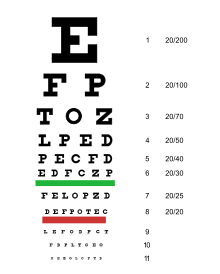December 20th, 2011 by Dr. Val Jones in Health Tips
No Comments »
 Most people assume that their eyes are healthy if their vision is stable, but this is not always the case. Eye doctors look for many different potential diseases and conditions during a comprehensive eye exam, and if you (or your children or loved ones) haven’t had one recently then maybe it’s time to make it a New Year’s resolution for 2012?
Most people assume that their eyes are healthy if their vision is stable, but this is not always the case. Eye doctors look for many different potential diseases and conditions during a comprehensive eye exam, and if you (or your children or loved ones) haven’t had one recently then maybe it’s time to make it a New Year’s resolution for 2012?
One CDC survey suggests that as many as 34.6% of adults over the age of 40 (with moderate to severe visual impairment) believe that they don’t need regular eye exams. This popular misconception may lead to missed diagnoses. Eye doctors look for signs of diabetes, high blood pressure, high cholesterol, glaucoma, multiple sclerosis, brain tumors, cataracts, macular degeneration, retinal tears, allergies and infections (among other things) each time they conduct a comprehensive eye exam. The exam offers a lot more than a simple vision check. And this is particularly important for children.
In a recent interview with the president of the American Optometric Association (AOA), Dr. Dori Carlson, I learned the surprising statistic that about 1 in 4 school age children have an undetected or undiagnosed vision problem. School vision screenings, while helpful, still miss more than 75% of these problems. And for those kids who are discovered to have a vision problem during a school screening, upwards of 40% receive no follow up after the diagnosis.
The eyes are more than a “window to the soul” but a window to general physical health. And the good news is that exams are relatively inexpensive and painless – so why not resolve to make them part of your yearly health maintenance routine, starting in 2012? Let’s make 2012 a year for healthy vision!
September 13th, 2011 by PJSkerrett in Health Tips, True Stories
No Comments »

It isn’t easy to get rid of a harmful habit like drinking too much, or to make healthy changes like losing weight and exercising more. Media stories about people who run marathons a year after surgery to bypass cholesterol-clogged arteries or who climb Mt. McKinley after being diagnosed with diabetes are interesting, but they don’t resonate with me. Mostly it’s because they often leave out the hard work needed to change and the backtracking that invariably accompanies it.
I ran across a truly inspiring story the other day in the American Journal of Health Promotion—one that shows how most of us ultimately manage to make changes that improve our lives. The journal’s founder and editor, Michael P. O’Donnell, wrote a moving essay about his father, Kevin O’Donnell. Once an overweight workaholic who smoked and drank heavily, ate mostly meat and potatoes, and didn’t exercise—and who eventually needed a double bypass—Kevin O’Donnell gradually made changes to improve his health. Now, at age 85, he has the cardiovascular system of a 65 year old and is working on a house-building project in North Korea.
How did Kevin O’Donnell engineer such a remarkable transformation? Read more »
*This blog post was originally published at Harvard Health Blog*
July 24th, 2011 by DeborahSchwarzRPA in Health Tips, Research
No Comments »

People with metabolic syndrome are twice as likely to develop heart disease, and five times as likely to develop diabetes, as those who don’t have metabolic syndrome. But many people are not yet familiar with this relatively new term. Do you know what metabolic syndrome is?

OECD Country Populations with a BMI > 30 (1996-2003)
Metabolic syndrome is the combination of several medical problems associated with morbid obesity. In addition to obesity, these conditions include: Read more »
*This blog post was originally published at Columbia University Department of Surgery Blog*
April 27th, 2011 by Dr. Val Jones in Opinion, Primary Care Wednesdays, True Stories
No Comments »
 A friend of mine is in great physical shape but her husband (we’ll call him “Mr. B”) has gained 40 pounds since they were married five years ago. He also has familial hypercholesterolemia, and several of his relatives have had heart attacks at young ages. Mrs. B is distraught – she is worried about her husband’s health, and has tried to gently nudge him towards healthier eating habits and regular exercise (as well as taking a statin for his cholesterol). Unfortunately, the nudges were received as nagging, and a wedge has formed between them in their relationship.
A friend of mine is in great physical shape but her husband (we’ll call him “Mr. B”) has gained 40 pounds since they were married five years ago. He also has familial hypercholesterolemia, and several of his relatives have had heart attacks at young ages. Mrs. B is distraught – she is worried about her husband’s health, and has tried to gently nudge him towards healthier eating habits and regular exercise (as well as taking a statin for his cholesterol). Unfortunately, the nudges were received as nagging, and a wedge has formed between them in their relationship.
Last week my friend planned a trip to a primary care physician in the hopes that he would educate Mr. B about the dangers of being overweight and not treating his high cholesterol. “Surely Mr. B will listen to an expert” she thought, “then perhaps he’ll realize that he has to change his behavior.”
Unfortunately, the primary care physician didn’t offer any health counseling to Mr. B. Not only did he not mention that Mr. B should lose weight, but he didn’t provide any warnings about the dangers of untreated, very high cholesterol levels. He merely reported that Mr. B’s total cholesterol was 300, and that a statin was indicated.
Mrs. B was crestfallen. She was depending on the physician’s authoritative input to help her come up with a strategy to steer her husband towards better health. Now Mr. B was left with the impression that things were more-or-less ok, and that his wife’s concerns were exaggerated. Read more »
December 13th, 2010 by PJSkerrett in Better Health Network, Health Tips, News, Research
No Comments »

 Stroke killed 2,000 fewer Americans in 2008 (the last year with complete numbers) than it did in 2007, the Centers for Disease Control and Prevention (CDC) said yesterday in its latest annual Deaths report. That dropped stroke from the third leading cause of death in the United States to the fourth.
Stroke killed 2,000 fewer Americans in 2008 (the last year with complete numbers) than it did in 2007, the Centers for Disease Control and Prevention (CDC) said yesterday in its latest annual Deaths report. That dropped stroke from the third leading cause of death in the United States to the fourth.
Good news? Yes and no. It’s always good news when fewer people die. The reduction suggests a payoff for efforts to prevent stroke and improve the way doctors treat it.
Yet the drop from third to fourth place is due largely to an accounting change. The CDC reorganized another category, “chronic lower respiratory diseases” (mainly chronic bronchitis and emphysema), to include complications of these diseases such as pneumonia. The change substantially increased the number of deaths in this category, which had long trailed stroke as the fourth leading cause of death.
More worrisome is that the decline in deaths from stroke isn’t matched by a decline in the number of strokes. On the rise since 1988, stroke now strikes almost 800,000 Americans a year, and that is expected to grow. Read more »
*This blog post was originally published at Harvard Health Blog*
 Most people assume that their eyes are healthy if their vision is stable, but this is not always the case. Eye doctors look for many different potential diseases and conditions during a comprehensive eye exam, and if you (or your children or loved ones) haven’t had one recently then maybe it’s time to make it a New Year’s resolution for 2012?
Most people assume that their eyes are healthy if their vision is stable, but this is not always the case. Eye doctors look for many different potential diseases and conditions during a comprehensive eye exam, and if you (or your children or loved ones) haven’t had one recently then maybe it’s time to make it a New Year’s resolution for 2012?




 A friend of mine is in great physical shape but her husband (we’ll call him “Mr. B”) has gained 40 pounds since they were married five years ago. He also has familial hypercholesterolemia, and several of his relatives have had heart attacks at young ages. Mrs. B is distraught – she is worried about her husband’s health, and has tried to gently nudge him towards healthier eating habits and regular exercise (as well as taking a statin for his cholesterol). Unfortunately, the nudges were received as nagging, and a wedge has formed between them in their relationship.
A friend of mine is in great physical shape but her husband (we’ll call him “Mr. B”) has gained 40 pounds since they were married five years ago. He also has familial hypercholesterolemia, and several of his relatives have had heart attacks at young ages. Mrs. B is distraught – she is worried about her husband’s health, and has tried to gently nudge him towards healthier eating habits and regular exercise (as well as taking a statin for his cholesterol). Unfortunately, the nudges were received as nagging, and a wedge has formed between them in their relationship. Stroke killed 2,000 fewer Americans in 2008 (the last year with complete numbers) than it did in 2007, the Centers for Disease Control and Prevention (CDC) said yesterday in its latest annual
Stroke killed 2,000 fewer Americans in 2008 (the last year with complete numbers) than it did in 2007, the Centers for Disease Control and Prevention (CDC) said yesterday in its latest annual 







